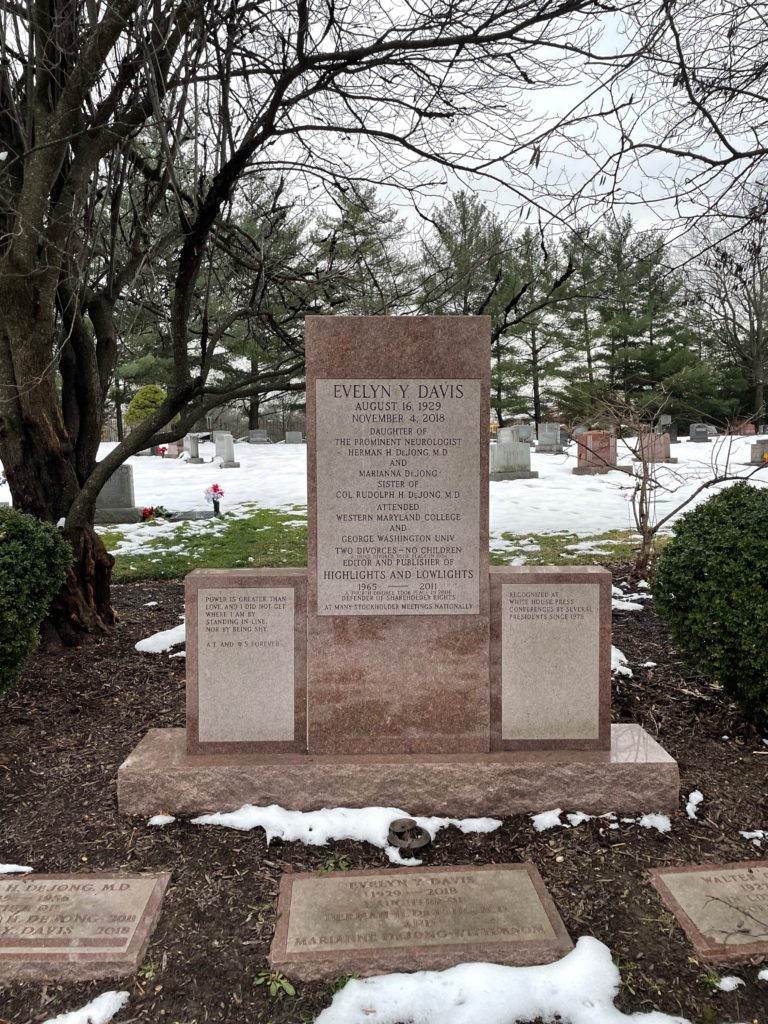Erik Visits an American Grave, Part 1,112
This is the grave of Evelyn Davis.

Sometimes you are in a cemetery and a grave stands out. When it is this chatty and filled with braggadocio, you take a picture of it and then you figure it out later. To say the least, that’s what Evelyn Davis’ grave is. I had never heard of her before. But this was a worthy shot of a worthy person. There’s no Wikipedia entry on her to give many of the basic facts of her life, but she got a New York Times obituary (wonder how many people have the latter but not the former).
Born in 1929 in Amsterdam, Evelyn DeJong was Jewish and her family fled the Nazis. They weren’t fully Jewish so they weren’t immediately sent to camps. But they were imprisoned. In fact, she was in a concentration camps in Czechoslovakia for a time but was one of the few people released. At this point, she fled to the United States, along with her parents and brother, in 1942. She attended George Washington University but dropped out. She then moved to New York and lived off the significant inheritance she got from her parents, which she invested. It was that investment that made her pay attention to just what CEOs were doing with her money.
Davis was a corporate reformer. She was one of the people in the 1960s who, like Ralph Nader, was disgusted at the irresponsible behavior of corporations. She was far from a labor person, who might have sought power for workers. Rather, she used the new path of shareholder activism, attempting to call out corporate leaders at their own meetings, get headlines, and embarrass them into better behavior.
Davis was not above using some pretty ridiculous theatrics to make this work. She would dress for the occasion. We can probably wonder whether wearing a Batman mask to an ABC shareholder meeting in 1966, shortly after the show premiered on the network, or whether wearing an aluminum dress in 1968 to a US Steel meeting got her respect or furthered her cause, but it did get her the attention she demanded and I guess we are talking about her today, so that’s something. She certainly could cause fury in her adversaries. At an Eastern Airlines shareholder meeting in 1970, someone pushed her into a flower pot. I dunno, maybe they should have spent more time fixing that disastrous company.
So you can talk about her as a bit of a clown and maybe she was. She embraced that. But remember that the mid-twentieth century was a period of time that was dominated by corporate arrogance toward consumers. Davis, like Nader, was one of the people who went out of their way to achieve corporate accountability toward shareholders. She wanted to know how much CEOs made, which politicians they donated to. In this, she was fairly effective.
When I teach the rise of conservatism in the 1970s and 1980s, one thing I note is that corporate America reemerged as an angry right-wing political force (I use the Powell Memo as a starting point for convenience sake but there’s plenty of moments around that time one could cite), there were three movements that they wanted to destroy. Each had forced them into new levels of accountability they could not stand. That’s the labor movement, the environmental movement, and the consumer movement. Davis was a key person in the third and if anything, it’s the movement we often don’t talk about often enough when it comes to this time period. Maybe that’s because Nader’s become a clown show over the last thirty years. But these people were really important. Corporations hated the idea of accountability and, quite obviously, still do. Crushing Nader and Davis and others like them was as important to them as crushing Walter Reuther or Rachel Carson.
Now, like a lot of this type of activist, Davis was really undisciplined. She might make good points, but as even sympathetic commenters noted, she could go on so long that she was often escorted from the room for going past time limits. As one leading worker on these issues noted of her behavior, “It made it too easy to marginalize not just Evelyn herself but anyone who wanted to raise those issues.”
Eventually, she became something of a legend in her own right, to the point that the corporate executives were almost glad to see someone they knew who would inject some humor into the proceedings. When Bank of America CEO won the Banker of the Year Award in 2008 (what a group of great people that must be….) he asked Davis to be his date to the black-tie dinner and she agreed.
Davis died in 2018. She was 89 years old.
Evelyn Davis is buried in Rock Creek Cemetery, Washington, D.C.
To say the least, Davis wanted to be remembered her way. Here’s a Washington Post article about the grave itself. How many graves get their own story in a paper of record?
If you would like this series to visit activists who tried to hold corporations accountable, you can donate to cover the required expenses here. Alice Lakey is in Westfield, New Jersey and Ruth Desmond is in Arlington. Previous posts in this series are archived here.


